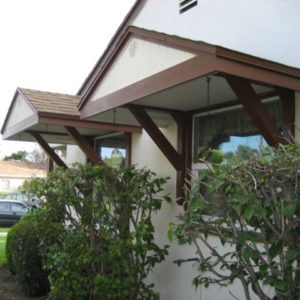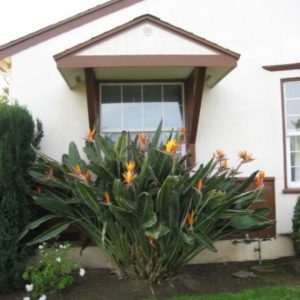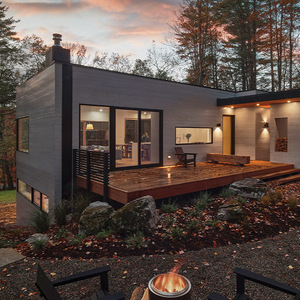What would you call this?
I built these modifications onto this old SoCal stucco home a while back, with the idea of keeping the sun off the glass while not obstructing the view. They also serve to reflect some of the noise from helicopters which often fly through this neighborhood.
I’m going to be selling this house soon and, as yet, have not come up with a good description for these small roofs.
For lack of a better name I’ve been calling them gabled awnings, but there must be a better phrase than that.
Who’s got a good marketing name for me?
Wiseazzery will be accepted with sublime equanimity.
Edited 3/14/2008 11:32 am by Hudson Valley Carpenter





















Replies
Architectural passive solar heat gain abatement accoutrements.
"Put your creed in your deed." Emerson
"When asked if you can do something, tell'em "Why certainly I can", then get busy and find a way to do it." T. Roosevelt
Excellent. It's a APSHGAA!
sunroofs?
Considering I don't know what equanamity means and I wouldn't want to be responsible for that condition if it's a bad thing, I will keep my whizeazz answers to my self.
The term "awning" implies some kind of tarp to me. What you have is far from a tarp. IMO, a "gabled awning" would look like pup-tent stuck to the side of your house.
What about "structural awning"? This might mitigate the tarp mindset.
Structural awning...hummm....sounds important. How about structural protuberance?
Structural protuberance
I had that once, but the doctor just told me to wait four hours and stop taking the little blue pill.
I think "gabled awnings" is perfect.
Why fix what aint broke?
They is what they is.
J. D. Reynolds
Home Improvements
Pp, Qq
It blocks the sun and looks like a dormer. How about a sun dormer.
It blocks the sun and looks like a dormer. How about a sun dormer.
That's one direction I've considered but calling it a dormer doesn't quite fit. Close.
Shade dormersWindow DormersI call them window awnings when they are not gabled like that.
Welcome to the Taunton University of Knowledge FHB Campus at Breaktime. where ... Excellence is its own reward!
This is really bad, and would probably only to people you wouldn't be interested in having in your home for showings. But, to me, that first picture looks like you gave your house a boob job.
But, to me, that first picture looks like you gave your house a boob job.
Eureka! It's a window bra.
What ever you call them use the term green in the discription, you so. cal. people eat that stuff up!
Doug
use the term green in the discription
Good idea. Whatever we call 'em, they're going on the green list.
Bris Soleil ("Bree Solay")--french for sun screen.
Bris Soleil
Perfect. SoCal is nothing if it isn't pretentious (We're all involved in the entertainment industry, don't ya know).
Ragnar17's got it right, a hood. I don't know why I didn't think of that. There are a million of them here on all the old houses in Portland (Maine).
A bris soleil is usually more of a pergola-looking thing anyway.
It is a nice pretentious-sounding name though.
While "hood" may fit the Maine nomenclature nicely, it'd be a real knee slapper, here in L.A. South Central is the only hood we ever hear about.
I'm more in favor of bris soleil, even though it makes me chuckle, than any other idea that's come up. Sounds like what a Beverly Hills architect would call it.
South Central is the only hood we ever hear about.
My bad. I din reconize u be livin in a hood. U needs to fine a diffent name fo dat ting on yo crib.
Peace out.
:P
Edited 3/12/2008 5:18 pm ET by Ragnar17
Yo Rags!
My name be Elma.
I wiv in Selma.
Selma, Awabamma
Ahm a bad mamma jamma.
Dis thang on my crib
don know what it iz
but it keep out de rayz
of the sun's purple haze.
Dis thang on my crib
don know what it iz
but it keep out de rayz
of the sun's purple haze.
Keepin it real, man! ;)
It's worth a LEED point or two. One for reduction of solar gain and one for innovation. I like um.
They look just like the small roofs often seen on older homes over a back door or side door (back when people still had enough sense to protect doors from the weather!).
But I don't know exactly what they're called, either.
Yep. That's where I got the idea. Pretty common over entry doors in Upstate New York.
I built one, a bit wider no doubt, over the front door of an old nondescript little house, many years ago.
I believe that, when it's over a door, it's called a portico. But that ain't official.
Seems like you rediscovered a good idea. I guess if you were to put enough of those independent little roofs over the windows, you would start approaching a covered porch (another great idea from the past!).
Anyhow, the work looks nice.
I'd say transplanted to the west coast and applied to a different problem, rather than rediscovered.
Anyway, I'm still looking for interesting names for this application.
Anyway, I'm still looking for interesting names for this application.
OK, here's a scan from a book I've got which contains a lot of graphical descriptions:
View Image
So I guess what we're dealing with is a hood. How about calling it a gabled window hood?
How about calling it a gabled window hood?
Like man, dis here is my hood and don't you forget it! ;-)
My thanks to all who've made an effort to come up with a name for this thing, Ragnar17 in particular for digging out a book, doing some research and scanning drawings to post here.
Without any established architectural precedent, what it seems to come down to is; modifying a locally accepted term to suit what I built.
As window covers here are all called awnings, looks like I'm stuck with "gabled awning"...at least until something more fitting comes along.
Thanks again for all the responses.
Edited 3/12/2008 10:49 am by Hudson Valley Carpenter
Thermal cooling/shading gabled awning.
Architectual thermal cooling gabled window awning.
Better than boob job?? but you are in LA ....
I believe that, when it's over a door, it's called a portico.
Windico?
J. D. Reynolds
Home Improvements
Pp, Qq
How about 'gabled window canopies'?
Lapun.
That's not bad but, like awning, it sounds like a cloth/canvas fixture.
Here in the U.S., awning is the more common term for anything which shades a window. Most such fixtures are either canvas or aluminum.
So it looks like I'll stick with "gabled awning". Or perhaps "gabled window portico".
Either way, they really do the job.
The pair in the first photo are on the west wall of the house. Before I added them to the cooling equation, the afternoon sunlight shown through the low E glass like it wasn't there, radiating enough heat to overcome the single modest 10,000btu window AC unit in the living room.
Since installing those two gabled awnings, the AC is able to maintain 80 degrees or lower throughout the house, even at times when the outside air temp is over 100.
While my neighbor's meter spins like a top, his old central air system soaking up heat from every conceivable source, my meter creeps around like an old woman with arthritis.
My electric bill is only about $1/day extra during the hottest days of the year, while the neighbor is paying an additional $15/day.
OK. If the perception is that 'canopy' represents short term protection, then that would not be attractive.As you know, Australia has more than enough sun for peoples' liking. In the days of 18 inch overhangs on timber houses with 10 foot ceilings, it was common to add metal shades. This also allowed folks to leave vertical sashes open during rain, to relieve the humidity.However, with AC now more common, larger overhangs perform the shade function.I can appreciate your problem with sun penetration vs AC power consumption. Just remember we never see snow here!Good fortune with the sale.Lapun.
Large overhangs are really ideal, in my opinion. That's what I'm planning for my next home in New York State.
I wonder what other features are seen in or on Australian homes which are different from what we usually do in the U.S.
You mentioned ten foot ceilings. I've seen higher ceilings in India, where AC isn't often in use. They also build thick exterior walls to help modify the inside temperature via thermal mass. Is that something that's popular in Australia?
Edited 3/12/2008 7:29 am by Hudson Valley Carpenter
When I was a boy, Australia (not unnaturally) tendered to be influenced by English architectural practice. But the climate put paid to that. Some local character began to develop, some of it odd in foreign regard.Two distinct types evolved. One was the "Homestead". and the other was the "Queenslander".The choice followed geographical location. Inland, where the heat was fierce, but the humidity was low, the low-set, wide and open verandahs kept the heat away from the core living areas. This gave rise to the 'homestead style'.On the coast, where temperatures were moderated by proximity to the sea,but humidity was relatively high, the high-set (houses-on-stilts)'Queenslander style' was more popular. Both styles, built in timber framing, were subject to rapid temperature rise, and as winters here are less severe, people got by with extra blankets.Both of these styles are only built these days by specialist builders for a very restricted market, usually on semi-rural sites.For the most part, domestic architecture now imitates your styles, losing any local character completely.If any of the above attracts you, let me know, and we can explore some of your options with pics and descriptions. I could identify some websites for your perusal.Lapun.
I'm always curious to see how local building customs arise and become established. For example, in Southern California the old style came from Spain where they had similar hot climates and simple organic materials.
Therefore the traditional way of buiding here encorporates lots of thermal mass for cooling; thick walls made of adobe blocks with surrounding covered patios and arbors to keep the sun off the walls.
Adobe is a combination of clay, straw, animal dung, and water, all mixed together then placed in square wooden forms to dry and harden. The blocks are laid up with more of the same mixture (without straw) as mortar, then plastered with a some of the same, but with more dung for adhesion.
There are still many examples of this kind of building in the local community but fewer and fewer as the years go by. Fortunately, the practice still prevails in Mexico so Americans will be able to visit there for their practical history lessons.
window roof
gabled window
crafted window roof
to be patented window roof
Sun boobs!
Corbel - A projecting block, sometimes carved or molded, that acts as a means of support for floor and roof beams as well as other structural members.
* This would describe the diagonal brackets holding it up
Pediment - A triangular section framed by a horizontal molding on its base and two raking (sloping) moldings on each of its sides; used as a crowning element for doors, windows, over-mantels, and niches. A pedimented entrance door and a pedimented window hood are illustrated.
* The illustrations don't show these projecting much more than decorative molding - they don't have brackets on the pictures.
Tympanum - The recessed triangular face of a pediment; sometimes contains a lunette, especially in domestic architecture.
* Not really relevant here, but proves there is a term for everything.
Portico - A covered walk or porch supported by columns or pillars; a colonnaded porch.
Above definitions from my wife's "Old-House Dictionary: An Illustrated Guide to American Domestic Architecture 1600 to 1940." by Steven J. Phillips
Given the above:
"Corbelled pediments on each window provide exceptional energy savings and noise reduction."
Sounds good, anyway. If they don't have any clue what this means, they can look at a picture or schedule a viewing!
-Nate
"Corbelled pediments on each window provide exceptional energy savings and noise reduction."
I luvz it! Corbelled pediments! Wow! That's a keeper.
Now if only the place wasn't a 50's tract home, of which there are literally millions in existence, I might be able to get away with calling them that. ;-)
Corbelled pediments...
But in his case, they're bracketed... and as you pointed out, they're not really pediments.
But I'm sure the real estate agents would love it! ;)
Intelligent Design?